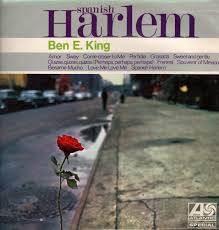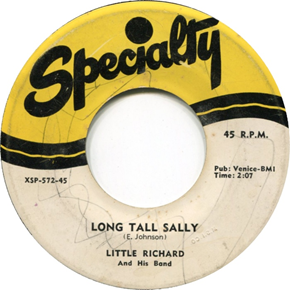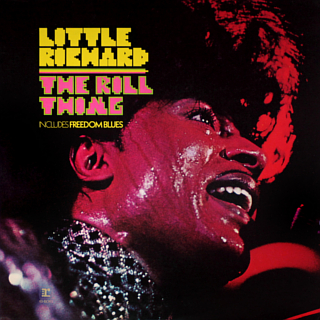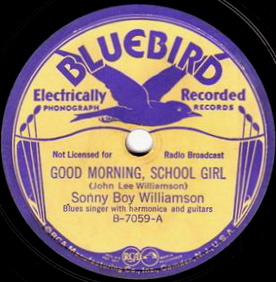Rhythm and blues, frequently abbreviated as R&B or R'n'B, is a genre of popular music that originated in African-American communities in the 1940s. The term was originally used by record companies to describe recordings marketed predominantly to urban African Americans, at a time when "urbane, rocking, jazz based music ... [with a] heavy, insistent beat" was becoming more popular. In the commercial rhythm and blues music typical of the 1950s through the 1970s, the bands usually consisted of a piano, one or two guitars, bass, drums, one or more saxophones, and sometimes background vocalists. R&B lyrical themes often encapsulate the African-American experience of pain and the quest for freedom and joy, as well as triumphs and failures in terms of relationships, economics, and aspirations.

Delores LaVern Baker was an American R&B singer who had several hit records on the pop chart in the 1950s and early 1960s. Her most successful records were "Tweedle Dee" (1955), "Jim Dandy" (1956), and "I Cried a Tear" (1958).
New jack swing, new jack, or swingbeat is a fusion genre of the rhythms and production techniques of hip hop and dance-pop, and the urban contemporary sound of R&B. Spearheaded by producers Teddy Riley and Bernard Belle, new jack swing was most popular from the late 1980s to early 1990s.
The origins of rock and roll are complex. Rock and roll emerged as a defined musical style in the United States in the early to mid-1950s. It derived most directly from the rhythm and blues music of the 1940s, which itself developed from earlier blues, the beat-heavy jump blues, boogie woogie, up-tempo jazz, and swing music. It was also influenced by gospel, country and western, and traditional folk music. Rock and roll in turn provided the main basis for the music that, since the mid-1960s, has been generally known simply as rock music.

"Ain't Nothing Like the Real Thing" is a 1968 single released by American R&B/soul duo Marvin Gaye and Tammi Terrell, on the Tamla label in 1968. The B-side of the single is "Little Ole Boy, Little Ole Girl" from the duo's United LP. The first release off the duo's second album: You're All I Need, the song - written and produced by regular Gaye/Terrell collaborators Ashford & Simpson - became a hit within weeks of release eventually peaking at number 8 on the Billboard Hot 100 and number 1 on the Hot Soul Singles chart, the first of the duo's two number 1 R&B hits. In the UK "Ain't Nothing Like the Real Thing" reached number 34.

"Spanish Harlem" is a song recorded by Ben E. King in 1960 for Atco Records. It was written by Jerry Leiber and Phil Spector and produced by Jerry Leiber and Mike Stoller. "Spanish Harlem" was King's first hit away from The Drifters, peaking at number 15 on Billboard's rhythm and blues and number 10 in pop music chart.

"Long Tall Sally", also known as "Long Tall Sally (The Thing)", is a rock and roll song written by Robert "Bumps" Blackwell, Enotris Johnson, and Little Richard. Richard recorded it for Specialty Records, which released it as a single in March 1956, backed with "Slippin' and Slidin'".

Tutti Frutti is a song written by Little Richard and Dorothy LaBostrie, recorded in 1955, which was his first major hit. With its energetic refrain, often transcribed as "A-wop-bop-a-loo-mop-a-lop-bam-boom!", and its hard-driving sound and wild lyrics, it became not only a model for many future Little Richard songs, but also for rock and roll itself. The song introduced several of rock music's most characteristic musical features, including its loud volume, powerful vocal style, and distinctive beat and rhythm.

"Night Time Is the Right Time" or "The Right Time" is a rhythm and blues song recorded by American musician Nappy Brown in 1957. It draws on earlier blues songs and has inspired popular versions, including those by Ray Charles, Rufus and Carla, and James Brown, which reached the record charts.

"Hit the Road Jack" is a song written by the rhythm and blues singer Percy Mayfield and recorded by Ray Charles. The song was a US number 1 hit in 1961, and won a Grammy award for Best Rhythm and Blues Recording, becoming one of Charles' signature songs. The song was played in the 1995 film Grumpier Old Men.

"Keep On Truckin'" is a 1973 hit song recorded by Eddie Kendricks for Motown Records' Tamla label. The clavinet-featuring song was Kendricks' first major hit as a solo artist, coming two years after his departure from The Temptations. "Keep On Truckin'" reached number one on both the Billboard Hot 100 and R&B Singles Chart upon its release, and was Kendricks' only number-one solo hit. It also reached #18 on the UK Charts. Vibes are played by Gary Coleman.
"That Lucky Old Sun (Just Rolls around Heaven All Day)" is a 1949 popular song with music by Beasley Smith and words by Haven Gillespie.

"Up on the Roof" is a song written by Gerry Goffin and Carole King and recorded in 1962 by The Drifters. Released late that year, the disc became a major hit in early 1963, reaching number 5 on the U.S. pop singles chart and number 4 on the U.S. R&B singles chart. In the UK it was a top ten success for singer Kenny Lynch, whose version was also released in 1962.

Departure is the debut studio album by English singer and songwriter Taio Cruz. It was released on 17 March 2008. The album entered the UK Albums Chart at number 17.

The Rill Thing is Little Richard's first album for Reprise Records, released in August 1970. It was considered a comeback album for Richard, following a three-year hiatus on new albums and an acclaimed performance at Atlantic City Pop Festival. The album utilizes a soul-influenced sound and contains Little Richard's biggest post-Specialty single in "Freedom Blues", which broke the Billboard top 50. The follow-up single, "Greenwood, Mississippi" made the top 100 and number 56 on Cashbox Black Singles. Despite the success of the singles, the album failed to chart.

"My Babe" is a Chicago blues song and a blues standard written by Willie Dixon for Little Walter. Released in 1955 on Checker Records, a subsidiary of Chess Records, the song was the only Dixon composition ever to become a number one R&B single and it was one of the biggest hits of either of their careers.

"Good Morning, School Girl" is a blues standard that has been identified as an influential part of the blues canon. Pre-war Chicago blues vocalist and harmonica pioneer John Lee "Sonny Boy" Williamson first recorded it in 1937. Subsequently, a variety of artists have recorded versions of the song, usually calling it "Good Morning Little Schoolgirl".
This article includes an overview of the major events and trends in popular music in the 1950s.

"My Best Friend's Girl" is a song by American rock band the Cars from their 1978 self-titled debut album on Elektra Records, released on June 6 of that year. Written by Ocasek as a song about something that "probably ... happened to a lot of people," the track found radio success as a demo in 1977.

I'm a Writer, Not a Fighter is the third studio album by Irish singer-songwriter Gilbert O'Sullivan, originally released by MAM Records in September 1973. After becoming one of the most successful performers worldwide in 1972, O'Sullivan pursued new directions with the album, taking influence from rock music and funk and incorporating an array of then-new electric keyboards, as well as emphasizing a new rhythmical focus. The album was recorded "on and off" with producer Gordon Mills at the latter's studio, and although several overdubs were recorded in the United States, O'Sullivan referred to the album as an ultimately "very ad hock home based" project.














